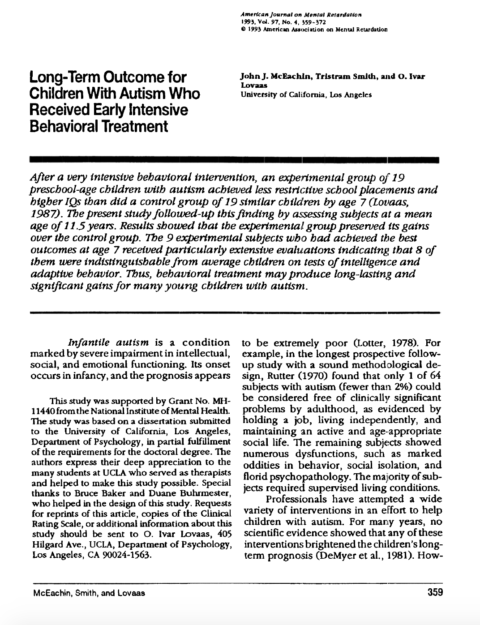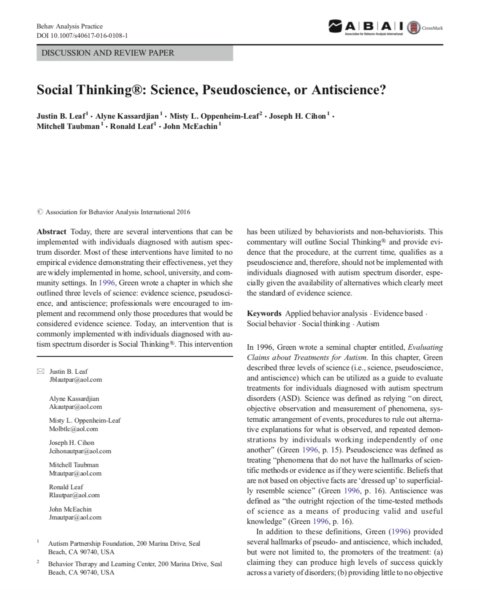This study provided a 5-year follow up on the progress of the children in the landmark study by Lovaas (1987). Specifically, we evaluated intellectual functioning, relationships with family members, independent functioning, use of leisure time, and socialization with peers through standardized measures. This study found that the results reported in the Lovaas (1987) study maintained for those individuals who received 40 hours or more per week of intensive behavioral intervention. That is, gains in IQ and adaptive behavior and decreases in maladaptive behaviors were only maintained for those individuals who received intensive behavioral intervention.
Research Papers & Journal Articles
Social Thinking® is a commonly used intervention by behavior analysts and other professionals for individuals diagnosed with autism spectrum disorder (ASD). Despite its common use, Social Thinking® appeared to lack research supporting its effectiveness and dresses up its methods and outcomes to superficially resemble science. This paper analyzes the current evidence-base on Social Thinking® and its level of science (i.e., science, pseudoscience, antiscience). The results showed Social Thinking® lacks research to support its use, displays many of the characteristics of a pseudoscience, and, as a result, should not be used with individuals diagnosed with ASD.
The creators of Social Thinking® (i.e., Michelle Garcia Winner & Pamela Crooke) responded to our initial analysis of Social Thinking®. As a result, we provided a second commentary addressing their response. In this commentary, we clarified the results of our original analysis regarding Social Thinking®, critically evaluated the definition of what constitutes an evidence-based practice, and further evaluated the research on Social Thinking®. The results were the same in that Social Thinking® lacks research to be considered evidence-based or empirically supported, is a pseudoscience, and should not be used with individuals diagnosed with ASD.
Many interventions for individuals diagnosed with autism spectrum disorder (ASD) rely on the use of tangible items (e.g., toys) as reinforcement. Within the Autism Partnership Method, we strive to move from using tangible items to social activities and interactions as quickly as possible. This study evaluated the effects of an observational learning procedure on changing children’s preference from tangible items to social interactions. The results for all three participants indicated changes in preference from a high-preferred tangible item to an initially low-preferred social activity/interaction by watching a peer select and engage in the social activity/interaction.
Due to the importance of prompting in autism spectrum disorder (ASD) interventions, many prompting systems have been developed. Many of these systems involve rigid rules for when and how to prompt. For instance, constant time delay involves providing a prompt after a specified time (e.g., 5 seconds). Within the Autism Partnership Method, interventionists are given the flexibility to assess in-the-moment and use clinical judgement to determine if a prompt should be provided, what type of prompt to provide, and how to fade the prompts. This system is called flexible prompt fading. This study compared constant time delay prompting to flexible prompt fading to teach receptive labels to children diagnosed with ASD. Results demonstrated that flexible prompt fading was just as effective and efficient as constant time delay prompting.





